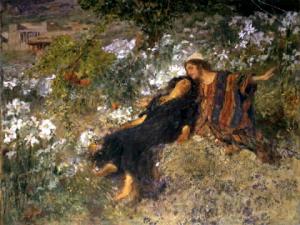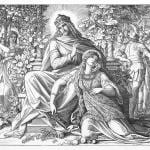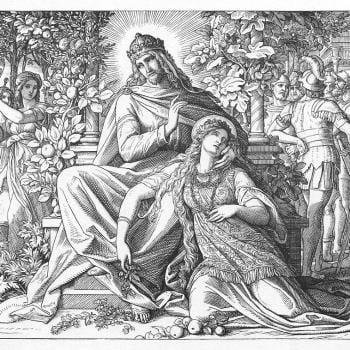Among the most prominent objections to the strictly allegorical reading of the Song is the strictly literal. Wary of the risks of conflating human sexuality with divinity, some exegetes seek to draw a decisive line between erotic and divine love. Southern Baptist theologian Duane Garrett views the erotic imagery of the Song as a celebration of the goodness of marital love in itself. The allegorical reading, according to Garrett, is problematic on the grounds of two key objections.

First, the allegorical method was used by pagans “who wanted to salvage morsels of truth from the stories about the [immoral behaviors] of their gods.” To claim that the erotic imagery speaks in an allegorical manner of God’s love for humanity would be to commingle the divine with the physical, a practice common in pagan fertility cults. The Song could not truly be an allegory of God’s love for humanity because it uses language that is “not appropriate for worship and spirituality…One cringes at using these terms to describe the love of God for his people.”
Secondly, “[a]llegorism of the Song is rooted in a neoplatonic worldview that was more gnostic than Christian.” Garrett claims that the philosophical foundation of asceticism is the notion that “the physical is bad and anti-spiritual…this viewpoint is contrary to the teachings of the Bible, which declares the creation of the physical world…to be ‘good,’ and which explicitly celebrates the union of man and woman…..spiritualizing the words prevents the hearer from appreciating how they celebrate the joy a young man has in his wife’s body.”
Garrett’s reading of Song 8:6 does not take the Hebrew “salhebetya” [resapeha rispe es salhebetya] to indicate that the burning flame of the bride’s love for the bridegroom is itself the “flame of Yah.” Rather, it is indicative of the might of the flame. Garrett does concede that one can liken the jealousy, or exclusivity, of the love between married persons to the jealousy of God’s love for his chosen. Yet, this does not in any sense imply a transcendent or divine dimension within marital love. “The comparison to death,” in Song 8:6 likely implies that “to marry is to give one’s life to another, and whoever marries has died to all others. Analogous to Jesus’ teaching that one must die in order to experience true freedom and life in the gospel, one must die to all extramarital sex in order to experience the joy of marital sex.”
Sister of Mercy Timothea Elliott argues that “salhebetya” is better translated as “flame of Yah” or “divine flame.” This translation would indicate that the conjugal union not only mirrors God’s love for humanity, but also is a transcendent experience in itself:
“Both resep and salhebet are terms associated with divine intervention. Here, salhebetya appears almost transparent as a divine personification of Love, particularly in light of the following verse (“many waters cannot extinguish Love, nor can rivers drown it” Song 8:7). Much more is suggested by 8:7 than the simple idea that love is a fire that many waters cannot put out…A very particular love relationship is defined as a creative force requiring an unbreakable bond of mutual commitment. Thus sealed, its power can only be compared to the unleashed primordial elements of fire and water. It fills the expanses of the cosmos, reaches downwards to the netherworld, and breaks its hold; it soars upwards like a flame to the transcendent experience of God Who is Love.”
A growing number of contemporary exegetes are reading the Song in light of both its literal and allegorical meanings. St. John Paul II acknowledges the Song’s allegorical implications regarding God’s love for the Church and the individual soul, but urges readers to recognize that the theme of spousal love, the “love of bridegroom for bride…is a theme by itself, and in this lies the singularity and originality of that book.” Only by first affirming the Song’s literal meaning regarding the transcendent dimension and inherent goodness of marital love can one understand its allegorical implications. “Although the analysis of the text of this book obliges us to situate its content outside the sphere of the great prophetic analogy, it is not possible to separate it from the reality of the primordial sacrament.”
In order to understand that sacramentality of the conjugal union, one must refer to “the beginning.” “The ‘language of the body,’ the visible sign of man and woman’s participation in the covenant of grace and love offered by God to man, is constituted. The Song of Songs demonstrates the richness of this language whose first sketch is already found in Genesis 2:23-25.” The desire of the bridegroom for his bride indicates the “readiness of the gift of self” in the conjugal act. “The love that unites them is of a spiritual and sensual nature together.” Thus, insofar as the spouse reciprocates the total gift of self in the conjugal act, they participate in God’s gift of self to humanity. Not only this, but the potentiality of the conjugal act to bear the fruit of new life allows the spouses to participate in God’s act of creating.
John Paul challenges the notion that erotic love is of a “carnal” nature. That which inhibits the conjugal act from participating in God’s transcendent love for humanity is not its carnality, its fleshliness, per se, but rather the extent to which it is encumbered by concupiscible desire. John Paul appeals to “the beginning,” when the man and woman were capable of freely giving of themselves and receiving the gift of each other, without the inclination to possess the other as an object, which resulted from concupiscence. Redemption in Christ allows the spouses to return to the beginning, and to recover that gaze toward the other which regards her in her alterity and full dignity.
The Jewish reader of the Song would understandably struggle to understand this third reading which appreciates both the literal and allegorical meanings of the text. Without the Incarnation and a theology of the Trinity, it would be difficult to claim that erotic love both reflects and participates in God’s love for humanity. The medieval objections to this reading lie in their struggle to make sense of the sacramentality of marriage. Is it consistent to hold that the conjugal act signifies God’s Love without effecting It? This would seem to be the result of a distorted view of the relationship between “the flesh” and concupiscence. Perhaps Garrett’s claim that ascetic theology relied too much on a gnostic suspicion of all things fleshly holds weight here. On the other hand, is it truly “pagan” and sacrilegious to relate marital love with divine love? Is the claim that a definitive line exists between the two loves consistent with the logic of the gospel?
Recent contributions to the philosophy of love can shed some light here. Catholic philosopher Jean-Luc Marion conceives of the conjugal act as a space in which the infinite and the finite, the earthly and the transcendent, meet. Far from “divinizing” the erotic, Marion recognizes the vast disparity between the finitude of human love and the infinite nature God’s love for humanity. Rather, he describes sexual climax as an intense “flash of light,” which in a sense reveals our identity as “lover” to ourselves. But this light vanishes; the experience leaves behind a memory that cannot be relived. He call this an “erased phenomenon,” which leaves the lovers in a state of suspension. The flame of eros tends toward and is kindled in the conjugal act, opening an empty space, a void which can only be filled by agape. This erasure drives the spouses to seek the total realization of what they experienced during that momentary “flash of light” by pursuing the flame of agape, together. Marion claims that the flame of eros is not separate from the flame of agape, but rather that they are different dimensions of the “one way of love.” “It is not a matter of two loves, but of two names selected among an infinity of others in order to think and to say the one love…agape possesses and consumes as much as eros gives up and abandons.” The distinction between the human experience of romantic love and the love of God is not categorical, but rather qualitative in nature. “God loves in the same way we do. Except for an infinite difference. When God loves…he simply loves infinitely better than we do.”
In the conjugal act, then, the person recognizes the erotic lover’s inability to satisfy the person’s expectation for total (infinite) fulfillment. At the same time, the act becomes the space which opens the lovers to the possibility of transcendence, of receiving an infinite love from the One whom my lover’s image recalls. “The erotic phenomenon, as it arises through the advance that makes the lover make love, paradoxically offers death no hold—precisely because it breaks free from the horizon of being. . . . The erotic phenomenon, as such, has no motive to succumb to death because it does not belong to the horizon of being.” The “erased phenomenon” of the climax opens the lovers to the “saturated phenomenon” of union with God. This echoes John Paul II’s vision of Adam and Eve’s gaze of wonder and fascination toward each other in the beginning, which in itself indicates the sacramentality of conjugal love. Perhaps it can be said that in this sense, marital love effects that which it signifies.
Considering the pre-Christian origin of the Song, I would question the extent to which one could validly claim that the author’s intended meaning was an indication regarding the nature of conjugal love itself. The allegorical reading seems to be the primary purpose of the Song, the literal implications holding a secondary or consequential value–and only so after the advent of the Incarnation. It could be said that the phenomenon of conjugal love participates in divine love by its very nature, and thus happens to allow one to find meaning within the literal reading of the Song, while it may not have been its intended or primary meaning.
The full version of this essay was originally published at Homiletic and Pastoral Review.
Click here to read part 1: Divine Eroticism: Medieval Readings of the Song of Songs












